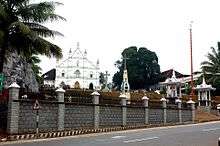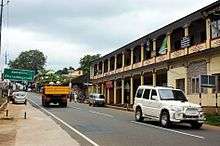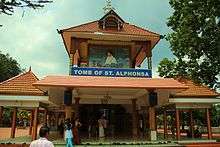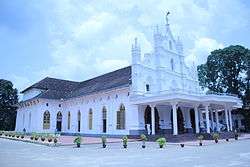Bharananganam
| Bharananganam ഭരണങ്ങാനം | |
|---|---|
| town | |
|
Bharananganam Syro-Malabar Catholic Church | |
| Nickname(s): Lisieux of India | |
| Coordinates: 9°42′00″N 76°43′40″E / 9.70000°N 76.72778°ECoordinates: 9°42′00″N 76°43′40″E / 9.70000°N 76.72778°E | |
| Country |
|
| State | Kerala |
| District | Kottayam |
| Population | |
| • Total | 17,000 |
| Languages | |
| • Official | Malayalam, English |
| Time zone | IST (UTC+5:30) |
| PIN | 686578 |
| Telephone code | 914822 |
| Vehicle registration | KL- 35 |
| Literacy | 100% |
| Lok Sabha constituency | Kottayam |
| Vidhan Sabha constituency | Pala |




Bharananganam, an important pilgrim centre in South India, is located on the banks of Meenachil river, 5 km east of Pala in Kottayam district in the state of Kerala. Bharananganam and surrounding places are bestowed with natural beauty due to hilly areas and lot of vegetation. Agriculture is the main occupation of the people, who cultivate plantation crops such as Rubber.
Demographics
The Population of Bharananganam comprises Catholic Syrian Christians and Hindus. The Syrian Christian community here is said to be 1000 years old, who migrated from the nearby Aruvithura area, along the upper course of the Meenachil River, in the 10th and 11th centuries. Also many other Christian families migrated to the region from other ancient Christian centers, in the following centuries. The community is traditionally into farming. Both the Christians and Hindus live in absolute peace and harmony.
Recent History
Bharananganam is known for its many aristocratic and affluent Nasrani families who've branched out from the place to other agrarian areas of Kerala, following the early agrarian expansion of Central Travancore, in the mid-19th century. This expansion lasted till the 1980s, with the last few waves of migrant Syrian Christians from in and around the area, migrating to the hilly villages of Northern Kerala.
Other major attractions
Sree Krishna Swami Temple
Bharananaganam is well known for Sree Krishna Temple in the banks of river Meenachil. This is one of the major temple of South Kerala. The east facing Sree Krishna Swami temple is located 1.3 km away from Bharanaganam junction in Ettumanoor - Poonjar State Highway. The 8 day long annual festival in Makaram (January) is a very vibrant event in the whole region commencing with the hoisting of the temple flag on Makara Samkramam day, and concluding with ‘Arattu’ (Ritual Bath of the deity) on 8th day. Besides the regular daily rituals the festivities include processions of the deity on elephant’s back to the suburban villages like Kizhaparayar, Keezhambara, Chittanappara and bharananganam (on 5 days) the precious ‘Utsava Bali’ (for 6 days) and art and cultural programs every day. The ‘Arattu’, typical of the 'Arattu' in almost any temple, is a magnificent night-long ceremony including procession of several elephants and performances by major percussion teams. The slow-moving procession of the caparisoned elephants carrying decorative silken umbrellas and other paraphernalia, illumined by multi-tongued oil torches, is a gorgeous spectacle, a delightful experience for the participants.
The official website of the temple is https://web.archive.org/web/20110202214457/http://bharananganamtemple.com/
Assisi Asram
Assisi asramam run by OFM cap missionaries also situated here. This Renewal Centre has completed 34 years of praiseworthy service in providing spiritual assistance to numerous people. It is to be noted that it is here the first Malayalam Charismatic retreat was conducted. This Renewal Centre publish a Malayalam magazine named "Assisi" and they manage a publishing house named "Jeevan Books".
Educational institutions
Bharananganam is famous for its elite institutions.
- St.Joseph's College of Engineering and Technology(http://www.sjcetpalai.ac.in)
- Alphonsa Residential School (ARSB) is the first ICSE syllabus school in Kerala and is named after Saint Alphonsa.
- Sacred Heart Girls High School
- St.Mary's Boys High School
Hindu legends associated with the place's name
Bharananganam is also known as Dakshina Guruvayoor (Guruvayoor of South) because of the presence of Sree Krishna Swami Temple. The place's name is closely associated with this temple. During their vanavasa (exile) Pandavas and Panchali stayed here for some days. On those days Yudhishtira performed Vishnu Pooja here. Yudhishtira decided to perform Dwadasi Pooja on Shukla Paksha Dwadasi day in the Malayalm month of Kumbham. But he had no idols of Lord Krishna to worship. Understanding the difficulty of His devotee, Lord Krishna gave a beautiful idol of Lord Vishnu to Vedavyasa Muni and Narada Muni and asked them to perform the pooja for Yudhishtira. Narada Muni and Vyasa Muni reached the place on the bank of holy Gauna (now Meenachil) river and installed the idol of Lord Vishnu in a suitable place and performed Vishnu pooja for Yudhishtira.
The sages performed abhishekam with Gauna river water. Pandavas and Panchali conducted the Paranaveedal ritual to end their vratha. They stayed there for some more days and later left to another place. While leaving that place they appointed a local Brahmin to conduct daily poojas and gave him the wealth to construct a temple. On that occasion there were not enough water in the river to conduct daily poojas. So Bhima dug a well near to the Lord's idol using his Gada. Later this place became famous as Paranaaranyam means forest where Paranaveedal was conducted. Paranakananam is the equivalent Malayalam word and later became Paranamkanam and after hundreds of years it became Bharananganam. Since the first abhishekam was conducted using Gauna river water, even today the first abhishekam in the early morning is conducted with river water and later with well water.
Saint Alphonsa's tomb
This small town is known as Lisieux of India after the birthplace of St. Theresa of Lisieux in France, The thousand year old St. Mary's Syro-Malabar Catholic Church here is one of the famous pilgrim centers of the Christians in Kerala. Also known as Anakkallu Palli, it is the place holding the mortal remains of Saint Alphonsa (1910–1946). Saint Alphonsa is the first woman to be conferred sainthood from the Kerala Church, which traces its origins to the visit of St. Thomas around 2,000 years ago to preach the gospel in India, and the second Indian to get that status after St Gonsalo Garcia. The death anniversary of Saint Alphonsa, which falls on 28 July is an important day for the devotees. Every year on this day, thousands of devotees visit this holy shrine, where the mortal remains of the saint is preserved, to pray and seek her blessings.

Saint Alphonsa lived a saintly life and was recognized as a saintly person during her lifetime. Even at a young age she showed a great zeal for suffering and she used to pray fervently and longed for sacrifice and fasting as and when possible. She believed that she must endure all things that tests her will and offer them to the Lord. It is said that in spite of her painful diseases, she was cheerful to the last. It was her students who established the cult of Saint Alphonsa. After her death, they began visiting her tomb and offering prayers. As they continued, they started receiving favours. Ever since, her tomb has been a centre of pilgrimage and innumerable miracles. The first officially confirmed miracle was that of, a disabled child miraculously cured of his ailment and his limbs restored, due to prayers at the altar of Sister Alphonsa's shrine. The miracle was approved in 1985 and the beatification of Sister Alphonsa was proclaimed by Pope John Paul II, during his visit to India in 1986. There is a two floored structure in front of the shrine which was originally the Papal podium for the beatification ceremony on 8 Feb.1986. Sister Alphonsa became Saint Alphonsa after she was canonised by Pope Benedict XVI at a ceremony at St. Peter's Square, Vatican on 12 October 2008. The Clarist convent where Sr. Alphonsa lived is located near St. Mary's Syro-Malabar Catholic Forane Church in Bharananganam. There is a museum adjacent to the convent chapel where the personal belongings of the Saint are well preserved.
Accessibility
- Nearest airport - Cochin International Airport - 78 km
- Nearest railway station - Kottayam - 32 km
- Distance to Cochin/Ernakulam - 70 km
- Distance to Kottayam - 32 km
- Distance to Pala/Palai - 5 km
- Distance to Thiruvananthapuram- 165 km
- Distance from Bharananganam to Keezhampara - 2 km
| Wikimedia Commons has media related to Bharananganam. |
